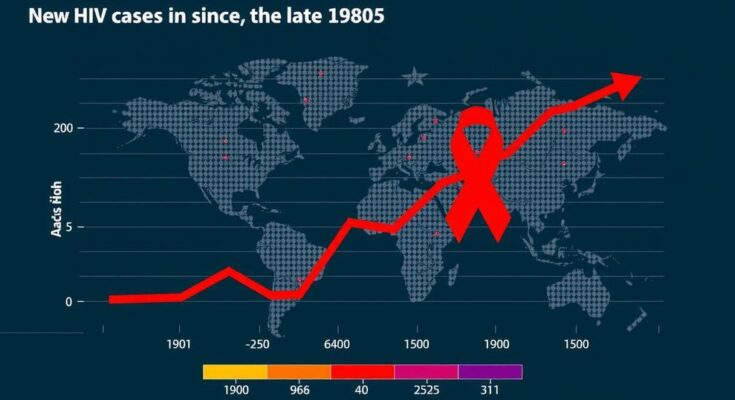UNAIDS reports the lowest number of new HIV cases since the 1980s, with 1.3 million new infections in 2023. While progress is noted, the number of deaths from AIDS-related illnesses remains high, and significant treatment gaps exist, particularly in accessing Pre-Exposure Prophylaxis (PrEP). Discrimination and legislation against those with HIV are significant barriers to progress. New treatments like lenacapavir present hope, but affordability issues could limit their impact.
According to a recent UNAIDS report, 2023 witnessed the lowest number of new HIV infections since the disease first emerged in the late 1980s, with approximately 1.3 million new cases documented. While this decline is noteworthy, it remains significantly short of the United Nations’ objectives to eradicate AIDS as a public health threat by 2030. Additionally, 630,000 individuals succumbed to AIDS-related illnesses last year, which is an improvement from a peak of 2.1 million deaths in 2004. The report attributes much of this progress to the widespread use of antiretroviral therapies that effectively manage viral loads in patients.
Despite these advancements, a concerning number of 28 countries reported an increase in HIV infections in the past year. UNAIDS emphasizes that the slow pace of implementing preventive treatments, such as Pre-Exposure Prophylaxis (PrEP), significantly hampers global efforts. Currently, only 15 percent of those who require PrEP are receiving it, highlighting substantial gaps in treatment accessibility.
UNAIDS Deputy Director Christine Stegling noted that advances in biomedical technology, human rights protection, and community activism have driven positive change. However, she cautioned that persistent injustices against individuals with HIV impede overall progress. Specifically, legislation that discriminates against these individuals exacerbates stigma, making it more challenging to combat the epidemic effectively.
Stegling stated, “But big gaps in the protection of human rights remain, and these gaps are keeping the world from getting on the path that ends AIDS.” The report further underscores the adverse effects of stringent laws, such as Uganda’s Anti-Homosexuality Act, on PrEP access and HIV prevention efforts.
Innovative treatment options, such as the new drug lenacapavir, have emerged as potentially transformative tools in managing HIV transmission. However, concerns about its high cost—approximately $40,000 per person annually—raise accessibility issues. Recently, Gilead, the manufacturer, announced partnerships with generic drugmakers to facilitate lower pricing in select lower-income nations, though critics highlight that many affected individuals may remain excluded from these agreements.
UNAIDS Executive Director Winnie Byanyima, who did not attend the press conference, has emphasized the necessity of ensuring widespread accessibility to new treatments to achieve meaningful reductions in infection rates. The urgency of these issues is underscored by a call from UN rights chief Volker Turk for justice regarding the situation of Byanyima’s husband, Kizza Besigye, amid ongoing political unrest in Uganda.
The global HIV/AIDS epidemic remains a critical public health concern, with the UN setting the ambitious target of eradicating AIDS as a public health threat by 2030. The latest UNAIDS report provides insights into trends in new infections and treatment accessibility, highlighting the successes and ongoing challenges faced in combating this disease. Despite advancements in treatments and a notable decrease in deaths related to HIV/AIDS, substantial obstacles, particularly discrimination and inadequate access to preventive measures, continue to hinder progress.
In conclusion, while the decline in new HIV infections and deaths signals significant progress in combating the HIV/AIDS epidemic, the overall situation remains critical. Urgent action is required to improve access to preventive treatments like PrEP, address human rights violations, and eliminate the stigma surrounding HIV. Failure to address these issues could impede the goal of ending AIDS as a public health threat by 2030. Ensuring that new, effective treatments are available to all affected individuals is paramount for sustained progress.
Original Source: www.seychellesnewsagency.com




